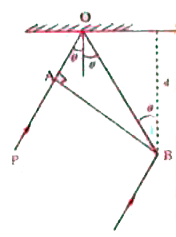For constructive interference to take place between two monochromatic light waves of wavelength λ , the path difference should be
(2n−1)λ4
(2n−1)λ2
nλ
(2n+1)λ2
The correct Answer is:3
To solve the question regarding the path difference for constructive interference between two monochromatic light waves of wavelength λ, we can follow these steps:
1. Understanding Constructive Interference:
Constructive interference occurs when two waves meet in phase, meaning their peaks and troughs align. This results in a wave of greater amplitude.
2. Path Difference Definition:
The path difference is the difference in the distance traveled by the two waves from their respective sources to a common point.
3. Condition for Constructive Interference:
For constructive interference to occur, the path difference Δx must be an integer multiple of the wavelength λ. This can be mathematically expressed as:
Δx=nλ
where n is an integer (0, 1, 2, 3,...).
4. Explanation of the Formula:
- When n=0, the path difference is 0λ, which means the waves are perfectly in phase.
- When n=1, the path difference is 1λ, meaning one wave has traveled one full wavelength further than the other.
- This pattern continues for higher integers n.
5. Conclusion:
Therefore, the path difference for constructive interference between two monochromatic light waves of wavelength λ should be:
Δx=nλ
Final Answer:
The path difference for constructive interference should be Δx=nλ, where n is an integer.
---
Constructive interference occurs when two waves meet in phase, meaning their peaks and troughs align. This results in a wave of greater amplitude.
The path difference is the difference in the distance traveled by the two waves from their respective sources to a common point.
For constructive interference to occur, the path difference Δx must be an integer multiple of the wavelength λ. This can be mathematically expressed as:
Δx=nλ
where n is an integer (0, 1, 2, 3,...).
- When n=0, the path difference is 0λ, which means the waves are perfectly in phase.
- When n=1, the path difference is 1λ, meaning one wave has traveled one full wavelength further than the other.
- This pattern continues for higher integers n.
Therefore, the path difference for constructive interference between two monochromatic light waves of wavelength λ should be:
Δx=nλ
The path difference for constructive interference should be Δx=nλ, where n is an integer.
Topper's Solved these Questions
- RAY OPTICS BOOK - VMC MODULES ENGLISHCHAPTER - RAY OPTICS EXERCISE - IN-CHAPTER EXERCISE-I
10 Videos
- RAY OPTICS BOOK - VMC MODULES ENGLISHCHAPTER - RAY OPTICS EXERCISE - IN-CHAPTER EXERCISE-J
10 Videos
- RAY OPTICS BOOK - VMC MODULES ENGLISHCHAPTER - RAY OPTICS EXERCISE - IN-CHAPTER EXERCISE-G
10 Videos
- QUIZBOOK - VMC MODULES ENGLISHCHAPTER - QUIZEXERCISE - PHYSICS
30 Videos
- RAY OPTICS AND WAVE OPTICS BOOK - VMC MODULES ENGLISHCHAPTER - RAY OPTICS AND WAVE OPTICS EXERCISE - IMPECCABLE
58 Videos
Similar Questions
Knowledge Check
When interference of light takes place
Aenergy is created in the region of maximum intensityBenergy is distroyed in the region of maximum intensityCconservation of energy holds good and energy is redistributedDconservation of energy does not hold good
In the Young's double slit experiment using a monochromatic light of wavelength λ, the path difference (in terms of an integer n) corresponding to any point having half the peak
View SolutionIn the Young's double slit experiment using a monochromatic light of wavelength λ, the path difference (in terms of an integer n) corresponding to any point having half the peak
View SolutionThere is a destructive interference between the two waves of wavelength λ coming from two different paths at a point. To get maximum sound or constructive interference at that point, the path of one wave is to be increased by
View Solution(a) Why are coherent sources necessary to produce a sustained interference pattern ?
(b) In Young's double slit experiment using monochromatic light of wavelength λ, the intensity of light at a point on the screen where path difference is λ, is K units. Find out the intensity of light at a point where path difference is λ/3.
View SolutionIn a Young's double slit set up using monochromatic light of wavelength λ the intensity of light at a point, where path difference is 2λ is found to be I0 What will be the intensity at a point when path different is λ/3 ?
View SolutionFor a single slit of width ''a'' the first minimum of the interference pattern of a monochromatic light of wavelength e occurs at an angle of λa. At the same angle of λa, we get a maximum for two narrow slits separated by distance ''a''. Explain.
View SolutionIn the figures PO and QB are the extreme rays of a wavefront AB of monochromatic light of wavelength λ. The value of angle θ for which the ray QB and ray OB interference constructively is

View Solution
